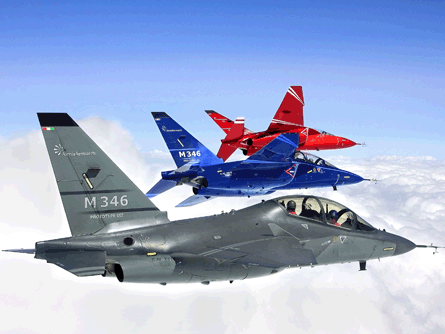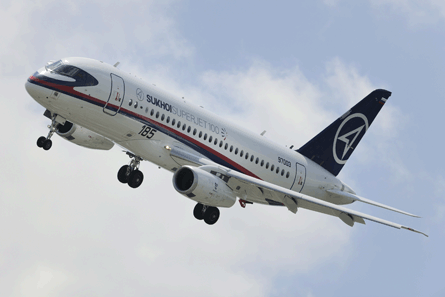 |
|---|
© Alenia AermacchiThe M-346 stands its best chance in the T-X contest if offered in partnership with a US defence giant, believes Finmeccanica |
The new brand presence was coupled with a determination not to be left behind by its European rivals BAE Systems and EADS in the rapid global expansion that followed the wave of consolidation at the turn of the century. Acquisitions such as GKN's Westland helicopter business and successes in competitions and programmes in the USA and elsewhere have propelled it on a firm expansion path, and across its three main business areas - defence and security electronics (Selex), helicopters (AgustaWestland) and aeronautics (Alenia Aeronautica) - Finmeccanica is showing healthy revenue growth.
With the $5.2 billion acquisition of DRS Technologies it closed in October 2008, Finmeccanica made two strategic advances considered key to long-term prosperity for any aerospace company operating in this post-9/11 world: it established a major footprint in the US market and made a significant move into homeland security.
For 2010, Finmeccanica comfortably held on at ninth place in the Flight International Top 100 ranking of aerospace manufacturers, with a $3.1 billion year-on-year surge to $20.8 billion aero sales in 2009 (the group also has energy and transport/rail businesses).
The company is snapping the heels of BAE Systems, the UK-based rival that has so masterfully moved its centre of gravity towards the USA, but which slipped back to eighth from fifth in 2009, with total aero sales now barely half a billion dollars ahead of Finmeccanica's.
Defence and security electronics highlights this year include sales to the third tranche of Eurofighter production, but much of the headline activity so far in 2010 has come from the AgustaWestland helicopters business. Top developments of the year to date include an Indian air force order for 12 AgustaWestland AW101 helicopters, completion of the acquisition of 87.7% of Poland's PZL-Swidnik, which makes helicopters and aerostructures, agreement of a joint venture with Tata Sons to perform AW119 final assembly in India and establishment of a joint venture with Russian Helicopters to build a final assembly plant in Russia for the civil version of the AW139.
Two other, particularly significant, results have been the $71 million sale, in October, of six AW139s in medevac configuration to the Maryland State Police Aviation Command, for production at AgustaWestland's Philadelphia plant and with delivery starting in 18 months, and an AgustaWestland-Boeing deal that will see an AW101 platform bid for the VXX US presidential helicopter programme.
The Boeing deal would give Agusta-Westland a significant role in the design and production stages of the VXX programme - and a confidence boost after the US Navy last year cancelled the AW101-based Lockheed Martin/AgustaWestland VH-71 presidential helicopter programme after its budget more than doubled to $13 billion and it was delayed by several years.
According to chief executive Pier Francesco Guarguaglini: "We are convinced that we continue to offer the best product available on the market today that is capable of meeting the specific requirement for this [VXX] programme. This was the case in the previous competition and remains true today.
"The new type of contractual relationship we have with Boeing makes us even more certain that all the conditions are in place to be able to win the bid. The recent success of the AW139 in the state of Maryland just reinforces the excellent reputation our AgustaWestland products already enjoy on American soil."
Finmeccanica's Alenia division is also enjoying US success. Through a tie-up with L-3, its C-27J Spartan turboprop has been selected for the US forces Joint Cargo Aircraft programme. The USA is also buying G222s, the C-27J predecessor, refurbished by Alenia, for delivery to the Afghan armed forces.
But Guarguaglini says these successes are unlikely to lead Finmeccanica in the short term to step up a level and make any solo bids as prime contractor for US defence contracts, as EADS has opted to do in the re-run of the US Air Force KC-X refuelling tanker competition after its partner, Northrop Grumman, decided earlier this year not to compete again.
He says: "Finmeccanica has been successful at drawing on industry, particularly small and medium-sized enterprises, to create integrated systems and this has enabled us to be extremely flexible in planning work and optimising costs. Today more than ever, the aeronautics sector revolves around highly complex products that require the integration of numerous different technologies, which means that working with other countries adds significant value, especially where competitiveness is concerned."
As for the forthcoming T-X programme to replace 450 USAF Northrop T-38 Talon trainers, Guarguaglini says the Alenia Aermacchi M-346, in its proposed US market guise as the T-100, stands its best chance of success if offered in alliance with "one of the leading US defence operators".
That programme, which some analysts regard as a must-win contract for trainer manufacturers, could involve up to 1,000 aircraft, including naval and light attack versions, and the T-X will become the most suitable trainer for air forces fielding Lockheed Martin F-35s, so potential for international sales is also vast.
CORE MARKETS
As for the defence business generally, Guarguaglini is not surprisingly clear about the need to look beyond core markets of Italy, the UK and the USA as these countries either cut spending or cease to increase their budgets.
To maintain group growth and profitability targets, sales attention is being focused on India, South America, the Gulf states and North Africa. Guarguaglini says the agreement signed in August with Panama to develop surveillance and national security systems "is symbolic, because it both demonstrates the validity of our strategy in emerging countries and is a reference model for the integration of systems and platforms developed by our different companies within the group".
 |
|---|
© Alenia AeronauticaQuality problems have given Alenia a bumpy ride on the 787 programme |
But he is also pleased with the outcome of the UK's strategic defence and security review. It "has reconfirmed that the majority of programmes which are of direct interest to Finmeccanica are going ahead", he says.
As for the civil side of the business, Finmeccanica's Alenia unit has, like most suppliers to Boeing's 787, had a bumpy ride through the programme's much-delayed development and production ramp-up phases, including the apparent origination at Alenia of quality control issues on some fuselage sections.
CHALLENGES AHEAD
However, Guarguaglini is sanguine about the challenges, noting that "for a company that produces cutting-edge technology, continuing technological innovation is directly linked to the design phase and, at a later stage, the operational and production phases of programmes.
"So that's why being involved in the creation of a product like the Boeing 787 Dreamliner is of fundamental importance for a group like Finmeccanica," he says.
"The leading role that we came to play in the 787 was the result of the willingness and the perseverance with which we have for years invested in demanding and complex research in the field of carbonfibre materials and their application to primary structures.
"Alenia is keen to continue as both a partner and supplier not only with Boeing but also with other commercial aircraft producers in the future, particularly looking at possible programmes concerning the narrowbody family."
Alenia is also heavily involved with Sukhoi in the Russian Superjet 100 project, holding 51% of the Superjet International joint venture that is marketing the regional aircraft. Guarguaglini stresses that the project is strengthening Finmeccanica's "already dense" network of relationships in Russia - "an excellent partner for Finmeccanica".
 |
|---|
© Alenia AeronauticaAlenia holds 51% of the Superjet International venture to market the Russian regional |
In China, he adds, Finmeccanica has no specific objectives but the group has "a significant presence" in transport and is "open to possible partnerships in the civil sector", which could include rail projects.
In helicopters, the priorities over the next few years include "pushing forward with successful aircraft such as the AW139 and AW149, which have been chosen by the US and Turkey, [and] developing new families of aircraft such as the AW169," says Guarguaglini.
"In aeronautics we will have to focus primarily on steps to maintain profitability in the aerostructure sector as well as driving forward key products on the international markets, such as aircraft which are entirely designed and produced by Alenia Aeronautica and Alenia Aermacchi, like the C-27J and the M-346."
He also highlights the challenges - and opportunities - in unmanned aircraft, composite technologies and green technology.
Finmeccanica, he says, is "looking to the future by building unmanned platforms specifically designed to demonstrate innovative approaches and technologies". With composites, the emphasis must be on both "leveraging the exceptional properties of the material, such as lightness, stability over time, adaptability to different shapes, versatility of use, low maintenance requirement and low percentage of waste material, and on developing new types of production processes".
Guarguaglini describes Alenia as being on the "front line of this new wave" of green technology by leading the regional aircraft programme in the European Union's Clean Sky research project. Clean Sky, he adds, covers "almost all areas of the aircraft, including structures, materials, innovative architectures for general systems and avionic and aerodynamic technologies".
Source: Flight International
















